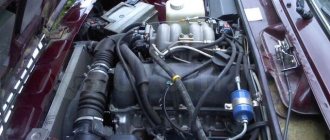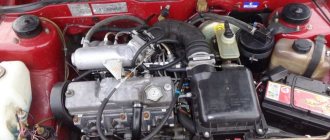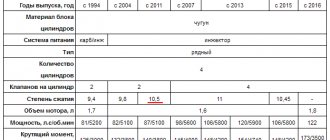The end of the 90s required automobile manufacturers to introduce new power units in order to withstand competition from foreign firms. Then AvtoVAZ engineers decided to supplement their already sensational tenth family of internal combustion engines with new engine options. After this, the well-known VAZ 2110 engine appeared, which gained popularity among car enthusiasts.
The VAZ-21083 power unit, which the design engineers significantly modified, served as the base model for the production of this engine. The carburetor was still used as a power supply system in the engine design, so there was no point in talking about special innovations.
Specifications
| Engine capacity, cc | 1499 |
| Maximum power, hp | 70 — 78 |
| Maximum torque, N*m (kg*m) at rpm. | 104 (11) / 3400 115 (12) / 3000 116 (12) / 3000 |
| Fuel used | Gasoline AI-95 Gasoline AI-92 |
| Fuel consumption, l/100 km | 7.6 |
| engine's type | In-line, 4-cylinder |
| Add. engine information | distributed fuel injection |
| Maximum power, hp (kW) at rpm | 70 (51) / 5600 71 (52) / 5600 72 (53) / 5600 77 (57) / 5400 78 (57) / 5400 |
| Compression ratio | 9.9 |
| Cylinder diameter, mm | 71 |
| Piston stroke, mm | 82 |
| Valve drive | SOHC |
| Number of valves per cylinder | 2 |
16-valve injector, 1.5 liters
With the advent of this engine, the design of the cylinder head became noticeably more complicated; two camshafts appeared at once.
At the same time, the procedure for replacing the timing belt has become not as easy as before, since two rollers and two camshaft pulleys have appeared. Everything had to be precisely adjusted according to the marks.
The main disadvantage of the 16-valve engine is that the valves bend when the timing belt breaks, which did not happen on previous engines.
The new control unit, improved design, and improved characteristics did not allow AvtoVAZ to achieve the desired result, since the reviews turned out to be quite negative when the VAZ 2110 was released with a new 16-valve engine.
Although, judging purely by technical parameters, the new product has significantly surpassed its predecessors.
Characteristics
Characteristic
1499 cubic centimeters
93 horsepower or 68 kW
7.2 liters per 100 kilometers
Having worked on the mistakes, AvtoVAZ engineers created the most successful and successful engine for the “ten” - a 1.6-liter power unit.
Peculiarities
The company's engineers produced the VAZ 2110 8-valve engine from 1995 to 2000. This power unit was produced in the city of Tolyatti, and it was based on its predecessor 21083. After the production of the engine was suspended, it was replaced by the VAZ-21102 fuel-injected internal combustion engine.
This is a classic in-line naturally aspirated engine running on gasoline for manufacturers. Its design includes four cylinders, giving a total working volume of 1.5 liters. The engine's peak power is 72 horsepower and its maximum torque reaches 104 Nm.
The engine block of the VAZ 2110 is traditionally made of cast iron with increased strength. The cylinders are machined directly into the block and it is not lined. The cylinder head is cast from aluminum. The crankshaft is made of cast iron, and it is fixed using five supports.
The material used to make the pistons was also classic - aluminum, only now they have steel inserts. The pistons are designed with two compression rings and one oil scraper ring. The connecting rods are made of steel and forged. The upper head contains a bushing made of a bronze-steel alloy.
The gas distribution mechanism is driven by a belt. If it is not replaced in time, it may break. But the VAZ 2110 1.5 engine is advantageous in that if the belt breaks, the pistons do not come into contact with the valves. The engineers managed to achieve this thanks to the fact that they made special grooves in the piston bottom.
The structure of the cylinder head provides for the presence of one camshaft and 8 valves. There are no hydraulic compensators in the design, so the thermal clearance of the valves will have to be adjusted independently. A combined lubrication system is used, and the gear-type oil pump is used.
A carburetor is used as a power system, only it has a semi-automatic start function. The carburetor was installed from a partner company - Solex, only this time it was different from the others, since it had two chambers.
Most owners of cars with such engines say that the power system is completely unpretentious to the quality of the fuel used. But despite such statements, it is necessary to choose gasoline solely based on the manufacturer’s recommendations.
The design uses a contactless ignition system. The high-voltage coil is installed dry and has a magnetic circuit, but there are other versions of the motor that provide for the installation of an oil-filled coil with an open magnetic circuit.
The VAZ 2110 engine cooling system is liquid, and is characterized by forced circulation of liquid. It is designed as a closed type, which allows it to provide an optimal operating temperature range not only in severe frost, but also in fairly hot weather.
Finding the VAZ 2110 engine number is not very difficult, since to do this you only have to dismantle the air filter housing. After this, you should pay attention to the place where the block connects to the flywheel, and above it you will find an identification number.
Modifications
The standard VAZ 2110 contains new developments and some features.
The first car was completely carburetor and 8 valve. This system had a volume of 1.5 liters and made it possible to develop about 70 horsepower.
This potential was enough to get real pleasure from movement. As for the maximum speed, it varies within 160 kilometers per hour.
After the carburetor engine, the designers decided to make an injector (already 16 valve). Essentially, these are the same 1.5 liters of volume, but with slightly increased engine power to 79 horsepower. This move made it possible to improve dynamism and increase maximum speed.
A small feature is that the system has a 16 valve VAZ engine. This is very unusual for cars of this class.
Until the 90s, the vehicle had a rather sparse interior and exterior. The designers made the car as a means of transportation, not a luxury. Only after the 90s were customers able to get a spacious trunk, comfortable seats, an adjustable steering wheel, air conditioning, and so on. Over the entire production period of the VAZ 2110, a huge number of modifications of its engine were developed: both an 8-valve carburetor and a 16-valve injector.
Advantages
The internal combustion engine turned out to be quite successful, despite the fact that it was not produced for very long. This resulted in the fact that it is quite common among domestic cars and their owners note a fairly large number of significant advantages:
- An interesting fact is that the VAZ 2110 engine can be started without any problems in almost any weather. The power system was designed to ensure uninterrupted operation in extreme cold and heat.
- The valves of the VAZ 2110 engine do not bend in the event of a break in the timing belt. This was achieved thanks to the special design of the piston, so there is no need to worry about having to overhaul the engine prematurely.
- Excellent pickup. Many owners of cars with such a power unit note that its use in urban conditions does not cause problems at all, since the power is enough to keep up with the flow.
- Good resource. Like all related engines, this engine can travel about 200 thousand kilometers without serious problems and the need for major repairs. But this can only be achieved if it is serviced in a timely manner.
- Unpretentiousness to fuel quality. In our country this is a very important factor, since most gas stations cannot guarantee high quality gasoline, but for this internal combustion engine this is undoubtedly not a problem.
Engine repair includes:
- complete disassembly of the engine;
- engine fault detection and diagnostics;
- selection of necessary parts;
- boring the cylinder block;
- flat-top cylinder honing;
- repair of connecting rod and piston group. Weight distribution.
- geometric renewal and restoration of the crankshaft (if necessary, its replacement);
- high-quality polishing of automotive crankshaft journals;
- installation and adjustment of the engine.
Problems
But despite a fairly large number of positive qualities, the engine is also characterized by classic malfunctions that most owners will have to face. Typically they are as follows:
- Fuel supply system. One of the most capricious parts of the engine is the carburetor. Owners of such engines no doubt know about the forced idle economizer and the main dithering system. It is also worth learning how to disassemble the carburetor in order to constantly clean the jets..
- Owners very often encounter constant fogging and leaks. Most often, the reason for this is that lubricating fluid begins to drip from the seals or around the valve cover.
- The temperature of the VAZ 2110 engine may be increased during operation. In this case, you should first pay attention to the thermostat, which may jam. If it is working properly, then you should check all the cooling system pipes for cracks.
- This engine also did not do without a lot of noise during operation. The cause of this problem may be a broken thermal gap in the valves. If this does not help, then you should start collecting money, since the pistons or main bearings of the crankshaft may start knocking.
- Often the VAZ 2110 engine troits. You shouldn’t start worrying right away, but just check the VAZ 2110 engine sensors, which often fail. All this can be eliminated literally in a garage and without additional knowledge.
Is the VAZ 2110 engine an injector or a carburetor? What are the differences?
Today, injection systems (not least due to the tightening of relevant environmental standards) have almost completely replaced carburetor analogues. However, not everything is so simple. When choosing a car, many future owners still have to answer the question: which is better - an injector or a carburetor?
First, you should say how, in fact, a carburetor differs from an injector, and you should also know how they work. In fact, the carburetor and the injector in the internal combustion engine perform similar tasks - fuel is supplied to the fuel rail from the tank, but the supply process itself is performed differently. In a carburetor engine, the air-fuel mixture, due to the pressure difference, is sucked into the combustion chamber.
This consumes some of the engine's power. At the same time, in an injection unit, the combustible mixture is injected directly into the combustion chamber. The injection process itself is controlled electronically, which is one of its advantages. This electronic system allows for precise dosing of the amount of incoming mixture.
Maintenance
In order to ensure optimal engine mileage, you just need to take good care of it. Fortunately, the design is as simple as possible, so there are no problems. First you need to pay attention to adjusting the thermal clearances of the valves. This must be done after traveling 20 thousand kilometers using washers.
Do not forget also about the lubricating fluid, which must be replaced after 15 thousand kilometers, since after that it loses its properties. Many people still don’t know how much oil is in the VAZ 2110 engine, and the answer here is quite simple - 3.5 liters, but during replacement you need to use 3.2 liters. Also, if you do not know what kind of oil to pour into the VAZ 2110 engine, then it is recommended to use types 10W-40 and 5W-40.
VAZ 2110 engine repair
VAZ 2110 engine repairs should be carried out with the obligatory use of working tools. You should never use wrenches that have worn edges, are missized, or use levers that increase the wrench's leverage. You should also not unscrew the nuts using a hammer and chisel.
The handles of the tools used must be plastic or wooden, and their surface must be cleaned and smooth. Handles made of wood should be equipped with metal rings to avoid splintering.
However, in addition to this, the injector also has its own disadvantages:
-difficulty in diagnosis and repair. Diagnostics of such a system requires specialized equipment, as well as qualified personnel. The mechanism components are quite expensive and have low maintainability.
-peculiar demands on fuel. Low-quality gasoline has an extremely negative effect on the reliability of the system. If you use fuel that contains a high content of mechanical impurities and various resins, specialists recommend regular washing of the injectors. Otherwise the system will fail.
At the same time, despite the popularity of injection systems, carburetor analogues are not going to give up their positions so easily. There are a number of explanations for this:
- They are easy to repair and maintain. The carburetor, unlike the injector, can be repaired even with your own hands, without special equipment. At the same time, cheaper spare parts and, in general, repairs will cost relatively affordable amounts.
- Undemanding to fuel. Systems that operate on a carburetor are less sensitive to “fuel” quality. Cars with such engines can run on AI-76 gasoline.
It should be said that this is where the main advantages of carburetor systems end, followed by disadvantages. It must be said right away that all of them are a mirror image of the advantages that injectors have:
- low efficiency, relatively high fuel consumption.
- high sensitivity to temperature changes. In winter it is prone to freezing, in summer it is prone to overheating.
- low reliability.











